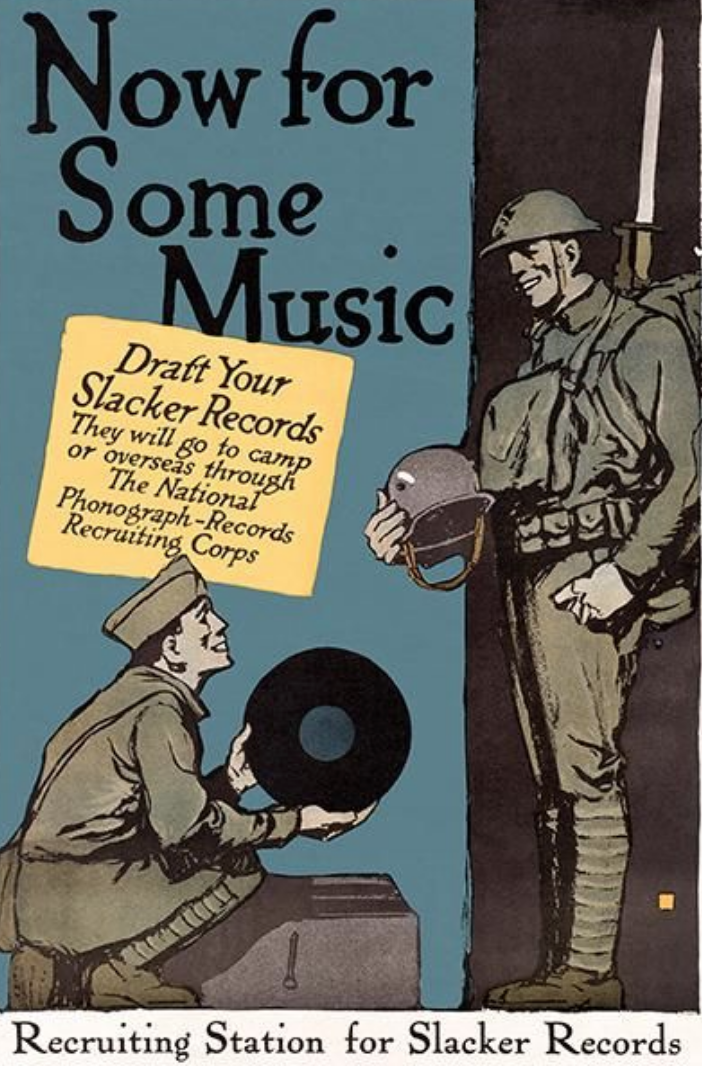"I’ll Be Seeing You": The Unifying Power of Music During a Crisis
Allison Quigley - 14 July 2020

In this 1918 World War I poster, soldiers collect records to increase morale. (Photo provided by the Library of Congress)
Written by Sammy Fain and Irving Kahal in 1938, I’ll Be Seeing You became one of many wartime songs during World War Two that provided citizens on the home-front with comfort and hope for the return of their loved ones. In fact, the song was popular enough to snag a number one spot in the music charts of 1944 (Whitburn, 1986). The song, melancholy in nature, united the masses in their stresses, anxieties, and worries. Although vastly different compared to World War, the sentiments of I’ll Be Seeing You, ring true amidst these days of social distancing. Unable to see our loved ones, friends, and coworkers, we walk the streets and familiar places, while memories of them invade our minds. Music was used, much like today, to give people a sense of unity and hope. Songs like I’ll Be Seeing You allow people to feel less alone, a shared suffering that provides people with hope for better days.
Music has been used in countless other times of crisis and moments of desperation. For example, in 1930, during the Great Depression, a time full of fear and diminished hopes, the arts and music became a “force in bolstering morale and getting people moving again” (Dickstein, 2009). In particular, swing music came to rise during this period and led to a boom in new dance choreography. From dance, music, photography, and to Hollywood films, the Great Depression relied on the arts to distract the public and inspire them of successes that seemed far from reach.
We are also vividly aware of how leaders have utilized music to inspire and unite collectives of people through shared emotions. For example, John Lennon’s songs Happy Xmas (War is Over) and Imagine “walked the streets with peace protestors and sustained anti-war movements” (Nardone, 2009). Lennon noted that after he witnessed the power of his 1971 Imagine, he understood what he had to do to be influential: “Put your political message across with a little honey” (2005). These famous songs, written in response to the vast destruction and horrors of the Vietnam War, helped nurture the masses in building upon the emotions of anger against unacceptable circumstances and hopefulness that change could be brought by banding together.
Music can bring together citizens, especially during times of uncertainty, and make “them feel like an organic part of the huge mass” (Hashemkhani, 2017). German Philosopher Friedrich Nietzsche observed the strength music had to unite the masses, whether at parades or religious ceremonies, and make individuals “feel uplifted, as if in ecstasy” (2017). Music has been used similarly during the Coronavirus pandemic. There has been a massive influx of at-home concerts, Instagram lives, drive-in concerts, and songs now affectionately labeled: “Quaran-tunes.” Music during the pandemic reassures people that even though they are physically distanced, our spirits remain together, hoping for better days.
Recently, CBC music had listeners vote on a official Canadian song during the Coronavirus pandemic. Blue Rodeos’ Lost Together was chosen:
Soon after the vote, CBC asked Canadians to record videos of themselves singing Lost Together to create a compilation video of Canadian citizens, at home, lost, during these uncertain times, but singing together in unity. The video is striking, and as you watch, it becomes real how many people heard the song and understood that they were among many facing similar trials. As my family and I listened to the song air for the first time on the radio, we were hypnotized by the lyrics, melodies, and greater meaning. We sat still in silence and even shed a few tears. When I think back to that moment, I think of the many who were at home during World War Two and listened to I’ll Be Seeing You. Like our predecessors who listened to melancholy, angry, and hopeful music, it helps to know that others understand our anguish and anxieties. Knowing this allows us to keep moving, hoping, and loving, even from a distance.
Leadership requires empathy and meeting people where they are. Music provides a bit of a window into what the masses feel and believe. In many ways, I think leadership shares some of the characteristics of music: push people not to give up, remain hopeful, and become passionate about foreseeable change. During this time, leaders can learn from initiatives such as CBC’s Lost Together. The feelings of hope and the shared human experience that music can create is something that leaders should draw on during this time to help reassure and inspire the masses.
Allison Quigley is a undergraduate student in the Faculty of Arts and a PLLC scholar.
References
“Billie Holiday - I’ll Be Seeing You (1944).” YouTube, uploaded by Okmusix, 7 May 2014,
www.youtube.com/watch?v=9l44_n60QQ8.
Dickstein, Morris. (2009). Facing the Music: What 1930s pop culture can teach us about our own
hard times. American Scholar, 78(4), 91-95.
Hashemkhani Zolfani S., Maknoon R., Juzefovic A. (2017). Leadership, Music and Creative Society: A Philosophical Analysis of Possible Future. Filosofija, Sociologija (Philosophy, Sociology), 28(1), 20-28. https://search-ebscohost-com.
Nardone, Jaclyn. (2009). John Lennon’s Political Lyrics in Popular Culture: From Resistance and Activism To Incorporation and Commodification. Peace & Conflict Monitor, EBSCOhost, search.ebscohost.com
“Watch 100s Unite for This Great Canadian Singalong of Blue Rodeo’s ‘Lost Together’ | CBC Music.” (2020). CBCnews, CBC/Radio Canada, www.cbc.ca/music/watch-100s- unite-for- this-great-canadian-singalong-of-blue-rodeo-s-lost-together-1.5567456.
Whitburn, Joel. (1986). The History of American Popular Music: Compiled from America’s Popular Music charts 1890-1954. Menomonee Falls, Record Research Inc., Internet Archives, https://archive.org/details/joelwpopmemories00whit/page/109/mode/2up.
Featured Image
Buckles , C. (1917). Now for some music. https://www.loc.gov/pictures/item/2002709060/. Accessed 4 July, 2020.